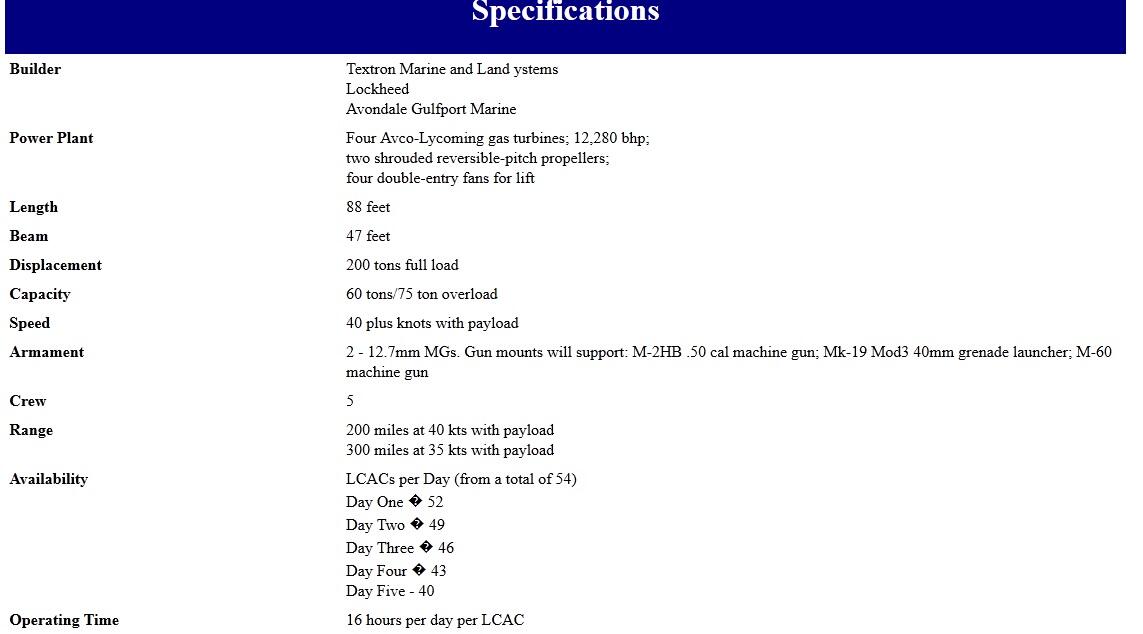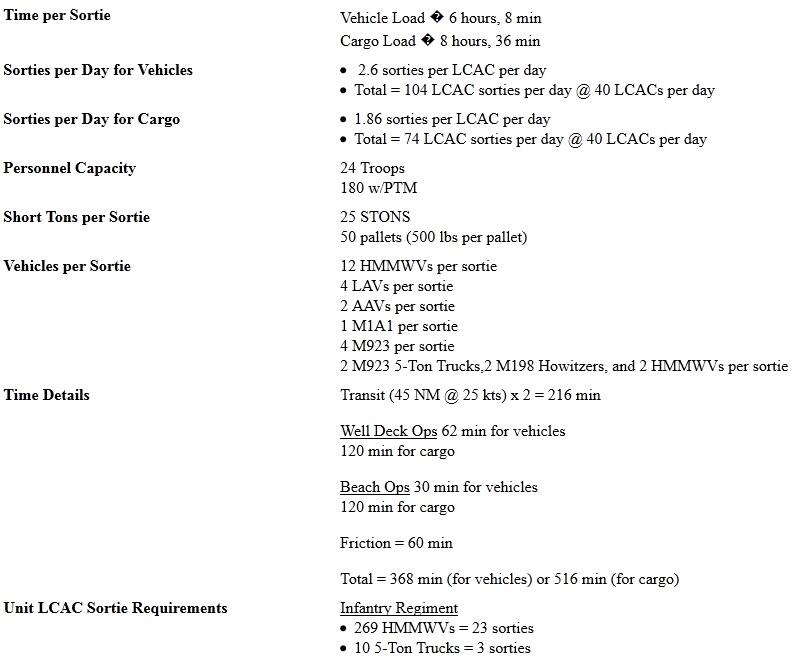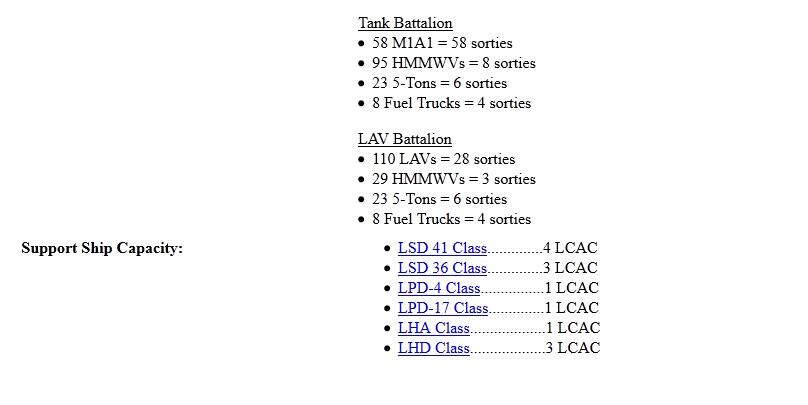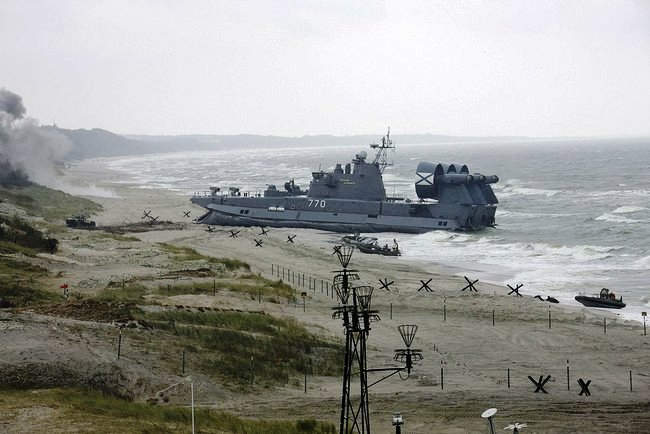TS
letnan.bejo
(Jendela rumah kita) Landing Craft, Air Cushion /LCAC, Zubr for TNI-AL
The Landing Craft, Air Cushion (LCAC) Transport weapons systems, equipment, cargo and personnel of the assault elements of the Marine Air/Ground Task Force both from ship to shore and across the beach. The landing craft air cushion (LCAC) is a high-speed, over-the-beach fully amphibious landing craft capable of carrying a 60-75 ton payload. Capable of operating from existing and planned well deck ships, it is used to transport weapons systems, equipment, cargo and personnel from ship to shore and across the beach. The advantages of air-cushion landing craft are numerous. They can carry heavy payloads, such as an M-1 tank, at high speeds. Their payload and speed mean more forces reach the shore in a shorter time, with shorter intervals between trips.

The LCAC is capable of carrying a 60 ton payload (up to 75 tons in an overload condition) at speeds over 40 knots. Fuel capacity is 5000 gallons. The LCAC uses an average of 1000 gallons per hour. Maneuvering considerations include requiring 500 yards or more to stop and 2000 yards or more turning radius. The LCAC, like all "hovercraft," rides on a cushion of air. The air is supplied to the cushion by four centrifugal fans driven by the craft's gas turbine engines. The air is enclosed by a flexible skirt system manufactured of rubberized canvas. Unlike the Surface Effect Ship (SES), no portion of the LCAC hull structure penetrates the water surface; the entire hull rides approximately four feet above the surface.

LCAC operates in waters regardless of depth, underwater obstacles, shallows or adverse tides. It can proceed inland on its air cushion, clearing obstacles up to four feet, regardless of terrain or topography), including mud flats, sand dunes, ditches, marshlands, riverbanks, wet snow, or slippery and icy shorelines. Equipment, such as trucks and track vehicles, can disembark via ramps located both forward and aft, there by shortening critical off load time.

LCAC is a dramatic innovation in modern amphibious warfare technology. It provides the capability to launch amphibious assaults from points over the horizon, thereby decreasing risk to ships and personnel and generating greater uncertainty in the enemy's mind as to the location and timing of an assault, thereby maximizing its prospects of success. It is also important to point out the LCAC propulsion system makes it less susceptible to mines than other assault craft or vehicles. Previously, landing craft had a top speed of approximately eight knots and could cross only 17% of the world's beach area. Assaults were made From one to two miles off-shore. Due to its tremendous over-the-beach capability, LCAC is accessible to more than 80% of the world's coastlines. It can make an undisclosed, over the horizon (OTH) assault from up to 50 miles offshore. Its high speed complements a joint assault with helicopters, so personnel and equipment can be unloaded beyond the beach in secure landing areas. For 20 years, helicopters have provided the partial capability to launch OTH amphibious assaults. Now, with LCAC, landing craft complement helos in speed, tactical surprise and without exposing ships to enemy fire.

With LCACs in the fleet, an amphibious assault force could be nearly 500 miles away at H-hour minus 24 and still make pre-dawn attack launched from beyond an enemy's horizon. The LCAC's air-cushion capability also allows it to proceed inland beyond an enemy's horizon to discharge cargo on dry, trafficable beaches, thus reducing build-ups of troops, equipment and other material in the surf zone.
_disembarks_Marines_and_their_equipment_during_a_Unitas_Gold_amphibious_assault_exercise.jpg)
LCAC was developed to satisfy the need for an air cushion landing craft capable of carrying troops, artillery, tanks, combat vehicles, and other major items of combat and combat support equipment across the beach. LCAC is the production follow-on to earlier advanced development craft which were tested by the Navy between 1977 and 1981. On June 29, 1987, LCAC was granted approval for full production. Forty-eight air-cushion landing craft were authorized and appropriated through FY 89. Lockheed Shipbuilding Company was competitively selected as a second source. The FY 1990 budget request included $219.3 million for nine craft. The FY 1991 request included full funding for 12 LCACs and advance procurement in support of the FY 1992 program (which was intended to be nine craft). The remaining 24 were funded in FY92. As of December 1995, 82 LCACs had been delivered to the Navy.

Initially, all testing had been conducted in Panama City, FL. Subsequently, the LCAC was tested in California, Australia, and in Arctic waters. Rough weather conditions forced cancellation of Exercise Valiant Usher 89-4, a joint U.S.-Australian amphibious assault exercise to be conducted off the northern Australian coastline. Objectives for tests in Alaska in March 1992 included evaluating all operational effectiveness and suitability concerns of multiple LCAC in an arctic environment. LCAC was neither operationally effective or suitable for arctic operations, and merely correcting the cold weather kit design would not be sufficient to conclude that LCAC was operationally effective and suitable in an arctic environment. Performance in opposed scenarios and in severe cold weather conditions would be necessary to fully evaluate LCAC performance. DOT&E recommended further operational testing. Developmental tests indicated that at colder temperatures engine power increases until gearbox torque limits capability, but icing and sea state would reduce that capability. Since then, LCAC has been used in two arctic exercises, one of which included operations in weather down to 15oF and realistic sortie rates. Based on this exercise, DOT&E concluded that further operational testing would not be necessary. LCAC demonstrated the ability to travel over light ice and open water, in fairly calm seas. The distance traveled per sortie ranged from 3-10 miles each way. Icing, which occurred in some conditions, also requires periodic interruption of missions to remove ice. JP-5 fuel was used, which alleviated problems with filters clogging. Also, LCAC has been involved in several minesweeping exercises, it has shown itself to be a potentially effective minesweeper in very shallow water. While this was not the original intent of the program, the system offers significant potential for enhancing force readiness.

The first deployment of LCAC occurred in 1987 with LCAC 02/03/04 embarked in USS GERMANTOWN (LSD 42). In July 1987 LCAC 04 transited Buckner Bay, Okinawa and conducted the first LCAC landing on foreign soil. The largest deployment of LCAC took place in January 1991 with four (4) detachments consisting of eleven (11) craft reporting for duty in the Persian Gulf in support of Operation Desert Storm.
The similarities between a Navy LCAC and an airplane are substantial. The craftmaster sits in a "cockpit" or command module with a headset radio on. He talks to air traffic control which for LCAC's is well-deck control located near a ship's sterngate. The ride feels like a plane in high turbulence. The craftmaster steers with a yoke, his feet are on rudder controls -- and he flies a lot like a hockey puck on an air hockey table, The LCAC is similar to a helicopter in that it has six dimensions of motion. Operating the LCAC demands unique perceptual and psychomotor skills. In addition, with a machine as expensive and inherently dangerous as the LCAC, sound judgment and decision-making also play an important role. Concerns over escalating training cost, projections for an increased number of LCAC vehicles and crew, and a high attrition rate in training highlighted the importance of developing a more accurate means of selecting candidates. Attrition of operators and engineers has dropped from an initial high of 40% in 1988 to approximately 10-15% today.
http://fas.org/man/dod-101/sys/ship/lcac.htm



+++++++++++++++++++++++++++++++++++++++++++++++++++++++++++++++++++++++++++++++++++++++++++
Zubr LCAC

Zubr is the world’s largest class of hovercraft. The Chinese navy placed an order for four craft at a reported cost of $315 million US dollars. Two were built by the Feodosiya Shipbuilding Company, and a second pair of vessels will be built in China under the supervision of Ukrainian technicians. The Zubr-class LCAC is a class of air-cushioned landing craft of Ukrainian design. This class of military hovercraft is the world's largest hovercraft. It is designed to sealift landing assault units from equipped/non-equipped vessels to non-equipped shores, as well as to transport and plant mines.

The Zubr hovercraft has a range of 483 kilometers at 55 knots and is capable of carrying 136 tonnes, including up to three medium tanks or 500 marines. Its top speed is more than 60 knots on land, water and ice, and it is capable of clearing obstacles 1.5 meters high. It has the carrying capacity for 3 main battle tanks with an overall mass of 150 tons or 10 armored personnel carriers weighing up to 131 tons plus 140 marines, or 8 infantry fighting vehicles with mass of up to 115 tons. If not equipped with armor, Zubr is capable of carrying 366 men.
+NAVY+(9).jpg)
Development of Zubr landing ships started in the former Soviet Union in 1978, and the first serial ship joined the Soviet navy in 1988. There were nine vessels of this class in active service around the world used by Russia, Ukraine and Greece. When Greece purchased four Zubr class hovercraft, it was the first time a Russian-built ship was owned by the navy of a NATO member. The hovercraft turned out to be more expensive to maintain than expected, and Greece retired two of them early so the parts could be used to keep the other two in service.
China's first Zubr LCAC hovercraft was built at the Feodosiya Shipbuilding Company in the Ukraine and adapted to Chinese needs so that no military weapons and electrical systems were installed. The first of four (LCAC) which was built for China was badly damaged in a construction accident in 2011. A cargo ship named HHL New York carries a Zubr-class LCAC hovercraft for the Chinese navy on the Zhujiang River in Guangzhou, capital city of south China's Guangzhou Province on Friday, May, 24, 2013. After a month long sea journey, an air-cushioned landing craft, Zubr-class LCAC built for the Chinese navy was delivered at Guangzhou, the capital city of south China's Guangzhou Provinc.
Ukraine turned over the second Zubr-class air-cushioned landing craft to China on 28 February 2014. China paid an estimated USD $80 million for each Zubr class LCAC. The first LCAC handed over in 2013 had already entered service in China.
The situation around Crimea risked disrupting the largest Ukrainian-Chinese warship building contract worth around $350 million, a source in the Ukrainian defense sector told Interfax 04 April 2014. Due to the events in Crimea, the implementation of the contract for construction of small Landing Craft Air Cushion (LCAC) at the facilities of FSK More in Feodosia for China remains an open question, the source said.
"Despite the fact that Ukraine has successfully performed its part of the contract for construction of the first two ships at the facilities of FSK More, and has already handed them over to the customer, the question of China's payment for the second small LCAC shipped to China in early March remains open," the source said. "At the same time, the force-majeure will require additional agreements with China and, probably, with Russia too, over the format of further cooperation under the contract that includes construction of two more small LCACs in China with participation of Ukrainian specialists," the source said.
"Being a reliable international-cooperation entity in the sphere of military-technical cooperation, Ukraine confirms its obligations under the contract," the source said. "Regrettably, their performance is currently compounded" by the situation around Crimea, he said.
Length 56.2 m
Beam 25.5 m
Draft 1.6 m
Displacement 550 t
Speed 60-63 knots
Range 300 miles
Crew 31
Engines 5 gas turbines M70 60,000H.P. (total)
Can carry 130t - 3 T-80 tanks and 140 rangers
http://www.globalsecurity.org/milita...china/zubr.htm
============================================================================================
sudah waktu kita berkaca pada diri kita dan melihat potensi ancaman serta kebutuhan akan transportasi yang serbaguna.
bisa buat SAR serta mampu meningkatkan gelar pasukan kita.
0
6K
7
Thread Digembok
Mari bergabung, dapatkan informasi dan teman baru!
Militer
20KThread•7.4KAnggota
Urutkan
Terlama
Thread Digembok